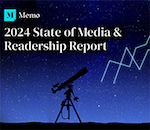Liz Spayd is new editor-in-chief and publisher of the Columbia Journalism Review, which this month gave a ringing endorsement of "accountability" (advocacy) journalism.
Spayd, who was at the Washington Post for 25 years until last November, most recently as managing editor, said the issue was completed before she arrived but that she agrees with it.
 Spayd |
The editorial, signed “CJR,” may have been written by Brent Cunningham, who was acting editor-in-chief, or the CJR staff. Titled “Access vs. accountability” is what matters, it says “public interest-oriented, accountability journalism” is “journalism’s most powerful and paradoxically its most vulnerable form.”
The January/February CJR has an article on staffer Dean Starkman’s new book The Watchdog That Didn’t Bark: The Financial Crisis and the Disappearance of Investigative Journalism.
The CJR editorial agrees with Starkman’s view that “access reporting,” as done by the financial press, “not only missed the story,” but “fueled the frenzy.”
Access journalism, according to the editorial, “seeks to provide insider information from powerful institutions and people. Accountability journalism seeks to provide information about those people and institutions. Put even shorter-hand, access reporting tells you what the powerful said, while accountability reporting tells you what they did.”
The difference was particularly important in the coverage of Wall Street and the mortgage business in the run-up to the Great Recession, the editorial adds.
Cost of the recession, according to economists who were quoted in the New York Times Jan. 22, range from $6 trillion to $14 trillion. The Dallas Fed, which made that estimate, said the cost is equivalent to $19,000 to $45,000 per person. Better Markets put the cost at $12.8 trillion.
Spayd Says Journalism “Nerve-Wracking”
Spayd, who joined the Post in 1988 as an editor on the business desk after being business editor of the Detroit News, said upon her appointment that “Journalism is shape-shifting into a form like nothing we’ve ever seen, a process that’s fascinating and invigorating but also nerve-wracking and confusing. It makes intelligent coverage of the field essential and I hope as we fortify CJR’s mission we’ll emerge as something of a North Star for those who care about journalism.”
She earned a B.A. in journalism from Colorado State University in 1981. Victor Navasky, chairman of CJR and the George T. Delacorte Professor in Magazine Journalism, said Spayd “is a strong editorial leader with very high standards and deep and varied experience in both legacy and digital media.”
Dean Steve Coll said she has “the skills to lead CJF into the digital era while delivering impactful journalism about the big personalities who are reshaping media, as well as subjects of great public importance such as the recent erosion of First Amendment protections.”


 Trump Media & Technology Group today reported a $58.2M net loss on $4.1M in 2023 revenues, a disclosure that drove its stock price down 22.6 percent to $47.96.
Trump Media & Technology Group today reported a $58.2M net loss on $4.1M in 2023 revenues, a disclosure that drove its stock price down 22.6 percent to $47.96. Barry Pollack, an attorney at Wall Street’s Harris St. Laurent & Wechsler, has registered Julian Assange as a client with the Justice Dept. “out of an abundance of caution.”
Barry Pollack, an attorney at Wall Street’s Harris St. Laurent & Wechsler, has registered Julian Assange as a client with the Justice Dept. “out of an abundance of caution.” Paramount Global to slash 800 jobs in what chief executive Bob Bakish calls part of an effort to “return the company to earnings growth"... Rolling Stone editor-in-chief Noah Shachtman is exiting at the end of the month due to disagreements with chief executive Gus Wenner over the direction the magazine is taking... The New York Times broke the $1 billion barrier in annual revenue from digital subscriptions in 2023... Press Forward is investing more than $500 million to strengthen local newsrooms.
Paramount Global to slash 800 jobs in what chief executive Bob Bakish calls part of an effort to “return the company to earnings growth"... Rolling Stone editor-in-chief Noah Shachtman is exiting at the end of the month due to disagreements with chief executive Gus Wenner over the direction the magazine is taking... The New York Times broke the $1 billion barrier in annual revenue from digital subscriptions in 2023... Press Forward is investing more than $500 million to strengthen local newsrooms. The majority of news articles are read within the first three days of publication, according to a recent report.
The majority of news articles are read within the first three days of publication, according to a recent report. The Los Angeles Times gives pink slips to 115 people or 20 percent of its newsroom staff... TIME is also laying off about 30 employees, which is approximately 15 percent of its editorial staff... The Baltimore Banner, which was launched by Stewart Bainum in 2022 after he failed to buy the Baltimore Sun, added 500 subscribers per day in the three days following Sinclair Broadcast Group's deal to purchase the Sun.
The Los Angeles Times gives pink slips to 115 people or 20 percent of its newsroom staff... TIME is also laying off about 30 employees, which is approximately 15 percent of its editorial staff... The Baltimore Banner, which was launched by Stewart Bainum in 2022 after he failed to buy the Baltimore Sun, added 500 subscribers per day in the three days following Sinclair Broadcast Group's deal to purchase the Sun.


 Have a comment? Send it to
Have a comment? Send it to 
No comments have been submitted for this story yet.